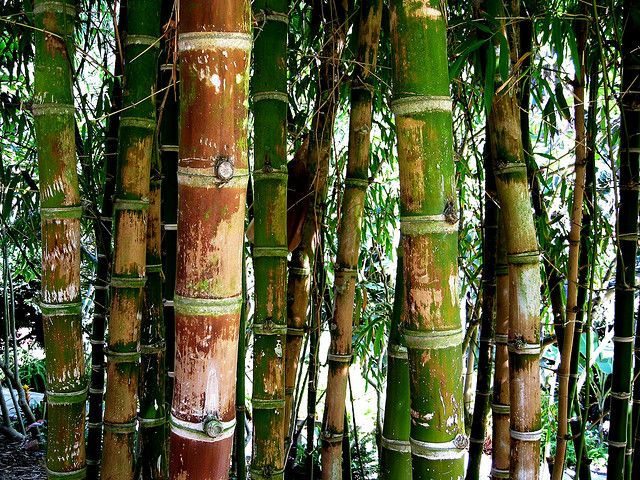
[dt_button link=»http://d165vjqq8ey7jy.cloudfront.net/mp3/19745/se-8243s.mp3″ target_blank=»true» button_alignment=»default» animation=»fadeIn» size=»small» style=»default» bg_color_style=»custom» bg_color=»#333333″ bg_hover_color_style=»custom» bg_hover_color=»#444444″ text_color_style=»custom» text_color=»#ffffff» text_hover_color_style=»custom» text_hover_color=»#dddddd» icon=»fa fa-cloud-download» icon_align=»left»]Скачать[/dt_button]
[dt_divider style=»thin» /]
Bamboo Crop of the Future
Voice 1
Welcome to Spotlight. I’m Ryan Geertsma.
Voice 2
And I’m Liz Waid. Spotlight uses a special English method of broadcasting. It is easier for people to understand, no matter where in the world they live.
Voice 1
A group of six buildings stands in two lines. It is the village of Noh Bo in Thailand. The buildings are made of a light brown wood. There are swings attached with ropes to the front of the houses. Children move back and forth on the swings. At night, the children climb up into the wooden house. They sleep on an upper floor that is cool and dry.
Voice 2
The local people say that the houses look like houses for butterflies. But they are houses for children! The children are orphans. They do not have parents to care for them. So they live together in an orphanage. And now they have good houses to live in.
Voice 1
The houses the children stay in are strong. They keep out water and heat. And they are built with local materials. The main building material is a plant — light brown bamboo.
Voice 2
Bamboo is a common woody plant. It grows tall and thin. It looks almost like a tree! It grows about 25 metres tall. It is about 15 centimetres wide. Bamboo looks like it is made of many small pieces. Thick lines divide it into small segments. And the inside of bamboo is empty. But it is hard and very strong. Today’s Spotlight is on how and why people use bamboo. Is it the crop of the future?
Voice 1
Many people think bamboo is a tree. But it is not — it is a kind of grass. It grows mainly in East and South East Asia. It also grows in Latin America, India and parts of Africa and Australia. Bamboo grows extremely fast and spreads very quickly. There are 1500 different kinds of bamboo. People all over the world use it. And people are planting more of it. Some people call bamboo ‘the crop of the future.’ They have many good reasons to plant bamboo.
Voice 2
There are over 1,000 uses for bamboo! Here are just a few:
Voice 1
People in the past used bamboo for many things. They made musical instruments and weapons with bamboo. Artists used it for paintbrushes and paper. Fishermen used it to make equipment for catching fish. Some people even made boats from bamboo!
Voice 2
In China and India, doctors use bamboo in traditional medicine. Bamboo is also very useful for cooking. People put food inside the empty bamboo plant. This is a good container for cooking soup, rice or tea. But people also eat bamboo as a healthy food. People eat the soft part, or shoot, of the bamboo in many ways. Most Asian countries have special foods made from bamboo shoots.
Voice 1
Bamboo has been used in traditional buildings. But builders also use it today! The village of Noh Bo is just one example.
Voice 2
There are many modern uses for bamboo. In 1879 Thomas Edison created the first light bulb. He made it with treated bamboo!
Voice 1
People also use bamboo to make cloth. Beauty products sometimes contain bamboo. It is even in some water filters, to clean water! People have even designed vehicles and airplanes out of bamboo. In Ghana, people even make two-wheeled bicycles from bamboo. In the Philippines, people make electricity from bamboo! Buildings, bicycles, light bulbs and even electricity: bamboo is an amazing plant.
Voice 2
These are just a few of the many ways people use bamboo. But bamboo is useful for a much more important reason. It is useful while it grows! Growing bamboo helps the environment in many ways. Bamboo provides oxygen, which improves air quality. It also reduces harmful carbon dioxide in the air. It does this more quickly than trees. Bamboo also provides shade and shelter from the sun.
Voice 1
In many places, hardwood trees are cut down for fuel or for building. This causes problems for the earth, animals, plants and air. To keep a good environment, people must replace the trees. But it takes a very long time for most trees to reach their full size. Many hardwood trees take 50 years to grow!
Voice 2
Bamboo is ready to use in only three years. Bamboo is the fastest growing woody plant in the world. It can grow about 60 centimeters in only one day. The bamboo plant grows to its full size in just three or four months. Some kinds of bamboo then become dry and hard. In three years, it is strong enough to harvest and use. And bamboo grows again when it is cut down. People can harvest it year after year.
Voice 1
Some people are sure that bamboo is ‘the crop of the future’. For example, Nicaragua has many hardwood forests. But people are cutting down three percent of the forests every year. One organization, Eco-planet Bamboo, is trying to replace these trees with bamboo. Troy Wiseman is a businessman with Eco-planet Bamboo. He explains their goals:
Voice 3
“My hope is that bamboo will replace hardwood timber. That way people can stop cutting down the forest. Bamboo is a resource that keeps growing. You can plant it on land that you cannot grow crops on. Bamboo is, in my opinion, the best replacement for hardwood.”
Voice 2
Eco-Planet Bamboo planted a large bamboo farm. Through this farm, Eco-Planet Bamboo hopes to improve the environment. They also hope to improve life for local people. Maribelle Urbina works on the bamboo farm. She told the BBC:
Voice 4
“I am very thankful that now I have a job. I am a single mother. I have five children. Before, I used to have very serious problems. Now I have enough money to care for my children.”
Voice 1
Bamboo is helping to reduce poverty in Nicaragua. John Vogel is the manager of the bamboo farm. He showed the BBC the town near the bamboo farm. Vogel explains:
Voice 5
“You can see more stores, more business, more activity. And the people are buying better houses. They are wearing better clothes. We are helping them also with health programs. You can see building activities. People are painting the houses.”
Voice 2
In Nicaragua, bamboo is providing jobs. Around the world, it is improving the environment and the economy. It is easy to see why people call bamboo the ‘crop of the future.’
Voice 1
The writer and producer of this program was Rena Dam. The voices you heard were from the United States. All quotes were adapted for this program and voiced by Spotlight. You can listen to this program again, and read it, on the internet at www.radioenglish.net. This program is called, ‘Bamboo: Crop of the Future’.
Voice 2
You can also leave your comments on our website. Or you can email us at radio at radioenglish dot net. You can also find us on Facebook — just search for spotlightradio. We hope you can join us again for the next Spotlight program. Goodbye.



